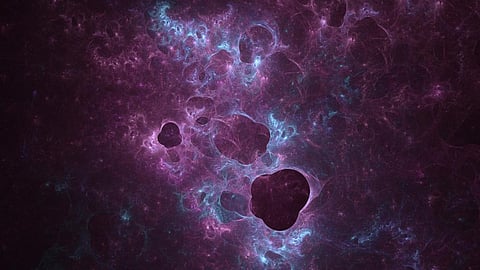New detailed map of dark matter agrees with Einstein’s theory of gravity: Study
Researchers have created a detailed map of the “hidden” dark matter that makes up 85 per cent of the universe.
Unlike normal matter that constitutes all stars and galaxies, dark matter does not absorb, reflect or emit light. It only seems to interact with gravity, making it challenging to detect.
Researchers from the United States, Canada and the United Kingdom used a ground-based telescope, Atacama Cosmology Telescope (ACT), to map dark matter using light emanating from the early universe when it was only 380,000 years old.
This research was presented at the Future Science with CMB x LSS, a conference being held from April 10-14, 2023 at the Yukawa Institute for Theoretical Physics, Kyoto University.
This “baby picture of the universe” is the cosmic microwave background (CMB) radiation or fossil radiation left over after the Big Bang.
“We have mapped the invisible dark matter across the sky to the largest distances and clearly see features of this invisible world that are hundreds of millions of light-years across,” Blake Sherwin, professor of cosmology at the University of Cambridge, where he leads a group of ACT researchers, said in a statement.
Being invisible, researchers observe how dark matter interacts with the gravity of massive objects such as galaxy clusters and lumps of dark matter.
The gravitational field generated by these massive objects bends and distorts light that passes through them.
“The CMB light gets deflected by dark matter, just like a magnifying glass deflects light that passes through it,” Sherwin told Down To Earth.
The clumps of dark matter, he added, magnify the appearance of objects that lie behind. The researchers look for this characteristic magnification in the CMB image to map the dark matter.
The map presents an image of all matter in the path of the CMB radiation.
Further, the new findings agree with the standard model of cosmology based on Einstein's theory of gravity.
“A big question in cosmology right now is how quickly the ‘lumps’ of dark matter form over time,” Sherwin noted.
These lumps, he added, are very important because we believe that galaxies form and grow in them.
The new measurements show that both the ‘lumpiness’ of the universe and the rate at which it is growing after 14 billion years of evolution are on expected lines.
Previous studies showed that these lumps are smaller than those predicted by the theory. These findings were based on the light emitted from stars in galaxies.
“We are not measuring exactly the same thing as in previous studies,” Sherwin said, adding that they probed lumps at earlier times and to a larger extent than other studies.
He, however, does not rule out the possibility that the difference in lumpiness is down to a rare statistical fluctuation or subtle errors in one of the datasets.


